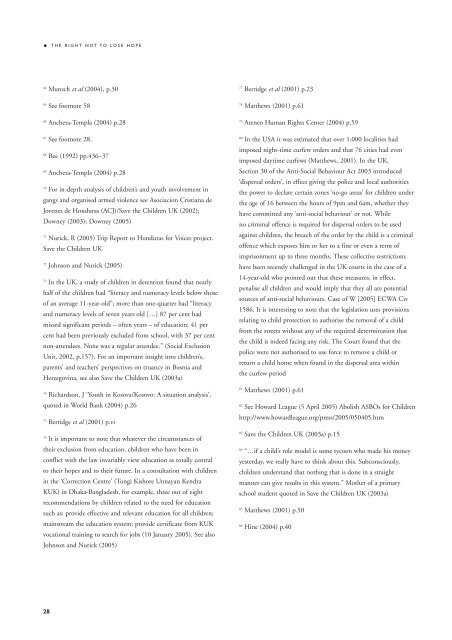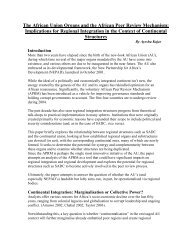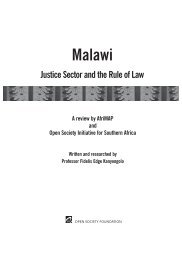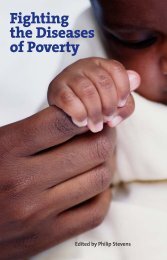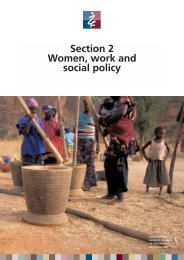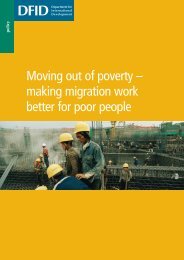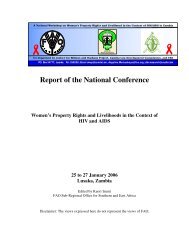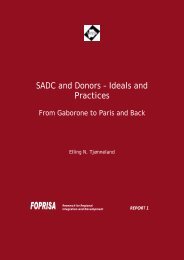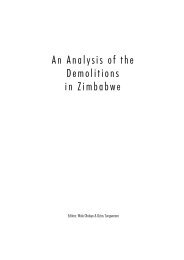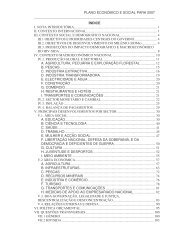The Right Not to Lose Hope - Violence Against Children - East Asia ...
The Right Not to Lose Hope - Violence Against Children - East Asia ...
The Right Not to Lose Hope - Violence Against Children - East Asia ...
- No tags were found...
You also want an ePaper? Increase the reach of your titles
YUMPU automatically turns print PDFs into web optimized ePapers that Google loves.
● THE RIGHT NOT TO LOSE HOPE64Munsch et al (2004), p.3065See footnote 5866Ancheta-Templa (2004) p.2867See footnote 28.68Bee (1992) pp.436–3769Ancheta-Templa (2004) p.2870For in-depth analysis of children’s and youth involvement ingangs and organised armed violence see Asociacion Cristiana deJovenes de Honduras (ACJ)/Save the <strong>Children</strong> UK (2002);Downey (2003); Downey (2005)71Nurick, R (2005) Trip Report <strong>to</strong> Honduras for Voices project.Save the <strong>Children</strong> UK72Johnson and Nurick (2005)73In the UK, a study of children in detention found that nearlyhalf of the children had “literacy and numeracy levels below thoseof an average 11-year-old”; more than one-quarter had “literacyand numeracy levels of seven years old […] 87 per cent hadmissed significant periods – often years – of education; 41 percent had been previously excluded from school, with 37 per centnon-attendees. None was a regular attendee.” (Social ExclusionUnit, 2002, p.157). For an important insight in<strong>to</strong> children’s,parents’ and teachers’ perspectives on truancy in Bosnia andHerzegovina, see also Save the <strong>Children</strong> UK (2003a)74Richardson, J ‘Youth in Kosova/Kosovo: A situation analysis’,quoted in World Bank (2004) p.2675Berridge et al (2001) p.vi76It is important <strong>to</strong> note that whatever the circumstances oftheir exclusion from education, children who have been inconflict with the law invariably view education as <strong>to</strong>tally central<strong>to</strong> their hopes and <strong>to</strong> their future. In a consultation with childrenin the ‘Correction Centre’ (Tongi Kishore Unnayan KendraKUK) in Dhaka-Bangladesh, for example, three out of eightrecommendations by children related <strong>to</strong> the need for educationsuch as: provide effective and relevant education for all children;mainstream the education system; provide certificate from KUKvocational training <strong>to</strong> search for jobs (10 January 2005). See alsoJohnson and Nurick (2005)77Berridge et al (2001) p.2378Matthews (2001) p.6179Ateneo Human <strong>Right</strong>s Center (2004) p.5980In the USA it was estimated that over 1,000 localities hadimposed night-time curfew orders and that 76 cities had evenimposed daytime curfews (Matthews, 2001). In the UK,Section 30 of the Anti-Social Behaviour Act 2003 introduced‘dispersal orders’, in effect giving the police and local authoritiesthe power <strong>to</strong> declare certain zones ‘no-go areas’ for children underthe age of 16 between the hours of 9pm and 6am, whether theyhave committed any ‘anti-social behaviour’ or not. Whileno criminal offence is required for dispersal orders <strong>to</strong> be usedagainst children, the breach of the order by the child is a criminaloffence which exposes him or her <strong>to</strong> a fine or even a term ofimprisonment up <strong>to</strong> three months. <strong>The</strong>se collective restrictionshave been recently challenged in the UK courts in the case of a14-year-old who pointed out that these measures, in effect,penalise all children and would imply that they all are potentialsources of anti-social behaviours. Case of W [2005] ECWA Civ1586. It is interesting <strong>to</strong> note that the legislation uses provisionsrelating <strong>to</strong> child protection <strong>to</strong> authorise the removal of a childfrom the streets without any of the required determination thatthe child is indeed facing any risk. <strong>The</strong> Court found that thepolice were not authorised <strong>to</strong> use force <strong>to</strong> remove a child orreturn a child home when found in the dispersal area withinthe curfew period81Matthews (2001) p.6182See Howard League (5 April 2005) Abolish ASBOs for <strong>Children</strong>http://www.howardleague.org/press/2005/050405.htm83Save the <strong>Children</strong> UK (2003a) p.1584“…if a child’s role model is some tycoon who made his moneyyesterday, we really have <strong>to</strong> think about this. Subconsciously,children understand that nothing that is done in a straightmanner can give results in this system.” Mother of a primaryschool student quoted in Save the <strong>Children</strong> UK (2003a)85Matthews (2001) p.5086Hine (2004) p.4028


